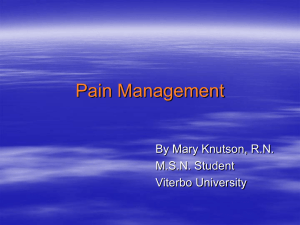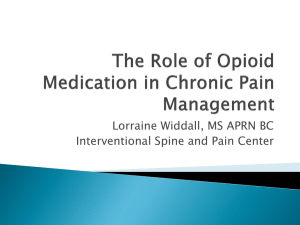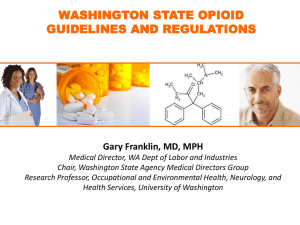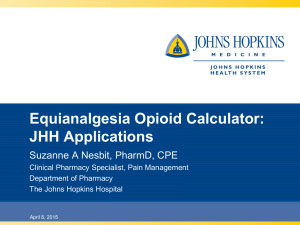management of chronic non-cancer pain
advertisement
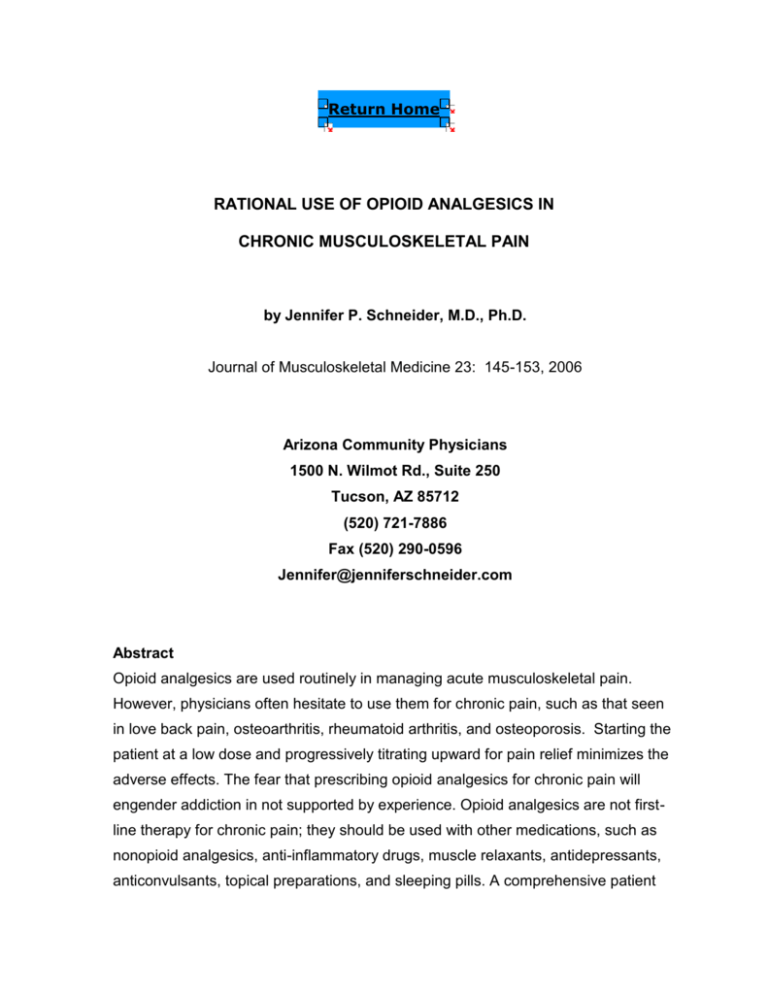
Return Home RATIONAL USE OF OPIOID ANALGESICS IN CHRONIC MUSCULOSKELETAL PAIN by Jennifer P. Schneider, M.D., Ph.D. Journal of Musculoskeletal Medicine 23: 145-153, 2006 Arizona Community Physicians 1500 N. Wilmot Rd., Suite 250 Tucson, AZ 85712 (520) 721-7886 Fax (520) 290-0596 Jennifer@jenniferschneider.com Abstract Opioid analgesics are used routinely in managing acute musculoskeletal pain. However, physicians often hesitate to use them for chronic pain, such as that seen in love back pain, osteoarthritis, rheumatoid arthritis, and osteoporosis. Starting the patient at a low dose and progressively titrating upward for pain relief minimizes the adverse effects. The fear that prescribing opioid analgesics for chronic pain will engender addiction in not supported by experience. Opioid analgesics are not firstline therapy for chronic pain; they should be used with other medications, such as nonopioid analgesics, anti-inflammatory drugs, muscle relaxants, antidepressants, anticonvulsants, topical preparations, and sleeping pills. A comprehensive patient assessment and an addiction history are essential. Consultation with a specialist in pain management is often helpful. Throughout history, various forms of morphine have been the most effective medications in relieving pain. Opioid analgesics – the natural, semi-synthetic, and synthetic derivatives of morphine – are routinely used in the treatment of acute musculoskeletal pain, myths and misunderstandings about the use of these drugs often prevent primary care physicians from prescribing them for common types of chronic pain, such as seen in common musculoskeletal conditions (e.g. low back pain, osteoarthritis, rheumatoid arthritis, and osteoporosis). Although pain is one of the most common symptoms that bring a patient to the physician's office, those with chronic musculoskeletal or other noncancer pain all too often are undertreated. In many cases, the use of opioid analgesics for patients with chronic musculoskeletal pain is a legitimate treatment approach, and it is gaining acceptance in the medical community. Although some reports question the efficacy of long-term use of opioid analgesics in improving function,12 several randomized controlled trials showed at least a 30% reduction pain. 13 Despite the efficacy of these medications are effective, physicians tend to underuse them because they lack knowledge about them and about addiction. They also fear regulatory scrutiny. In this article I review the properties and adverse effects of opioid analgesics and describe the differences between physical dependency and addiction. I discuss how to assess patients who have chronic pain, determine the appropriateness of treating them with these agents, and monitor them on a regular basis. Effects and adverse effects Opioid analgesics exert their effects by binding to mu, kappa, and delta receptors in the CNS (brain and spinal cord), the GI tract, and to a lesser extent, in the peripheral tissues. They counteract pain signals ascending to the brain. Pain relief is their desired effect, but they also have adverse effects (e.g., nausea, sedation, and constipation). Starting the patient at a low dose and progressively titrating upwards for pain relief minimizes the adverse effects while permitting development of tolerance (the need for an increased dose to get the same effect, or a diminishing effect with the same dose) to the nauseating and sedating effects. Tolerance to nausea, sedation (and its extreme, respiratory depression) is desirable, but there is no tolerance does to the constipating effect of opioid analgesics. Therefore, it is important for the patient to maintain a bowel regimen (stool softener, bowel stimulant, fluids, and activity) as long an opioid analgesic is being prescribed. Tolerance to the pain-relieving effects of opioid analgesics is uncommon. Once titrated to an effective pain-relieving dose, most patients remain on the same or similar dose for long periods.1 Pain specialist Dr. Russell Portenoy wrote, “Contrary to conventional thinking, the development of analgesic tolerance appears to be a rare cause of failure of long-term opioid therapy. 2 Although there is some evidence to indicate that long-term exposure to high doses of opioid analgesics results in hyperalgesia (increased pain sensitivity), this is rarely of clinical significance. 3 Most often a request for increased dose reflects increased physical activity, a worsening physical problem, or deterioration in psychological status (e.g depression). An often unappreciated adverse effect of chronic opioid use is lowered sex hormone levels in men. In those who are taking significant doses of opioid analgesics long-term, subnormal testosterone levels are the rule rather than the exception.4 Plan on checking total and free testosterone levels in all male patients on moderate to high doses of opioids. Many will need testosterone replacement, preferably with patches or transdermal preparations. It is wise to follow their prostate-specific antigen levels as well. I recommend checking testosterone levels even in asymptomatic patients. Untreated hypotestosteronism can lead to osteoporosis in men as well as decreased muscle strength. Some patients taking morphine is itching. Morphine is more likely than other opioid analgesics to cause histamine release and pruritus. If antihistamines don’t provide enough relief, switching to another opioid may be the answer. There is no accepted upper limit of safety for opioid analgesics. Because of genetic differences and varying pathology, there are enormous differences in how much of opioid analgesics they need for adequate pain relief. Historically, some cancer patients have required grams of morphine. For many patients, however, 5 mg of hydrocodone (in Vicodin or Lorcet) provides adequate pain relief. As long as the dose is begun low and increased gradually, large doses can be taken, limited only by adverse effects. Unlike acetaminophen, aspirin, and many other drugs, opioid analgesics do not have any specific organ toxicity. Therefore, the right dose is the one that provides adequate pain relief without unacceptable adverse effects. Typically it takes 3 to 7 days for the body to overcome sedation produced by opioid analgesics. Therefore, it is wise for patients to avoid driving when beginning these drugs and while increasing the dose. Once patients are taking a stable dose and feel alert, generally it is safe to drive because they have adequate psychomotor functioning 5 , 6,7 Of course it is wise to avoid using alcohol and benzodiazepines before driving, because they are likely to increase any sedative effects of opioid analgesics. Opioids are significantly safer than NSAIDs. Specifically, they are not associated with either upper GI bleeding or renal toxicity. This may be particularly important in older patients who are at risk for GI and renal toxicity of NSAIDs. Physical dependency versus Addiction. Many physicians and lay persons believe that anyone who is taking opioid analgesics long-term becomes addicted. This misunderstanding results from confusion with the concepts of physical dependency and addiction. Physical dependency This is a form of physiological adaptation to the continuous presence of certain drugs in the body. Abrupt discontinuation of the drug after the body has become accustomed to it results in a predictable withdrawal syndrome. For opioid analgesics this may include anxiety, irritability, goose bumps, salivation, lacrimation, rhinorrhea, diaphoresis, nausea and vomiting, abdominal cramps, and insomnia. Withdrawal from morphine starts at 6 to12 hours after last use and peaks at 1 to 3 days. Longer-acting opioids such as methadone have a slower onset of these symptoms, and they are less severe than with shorter-acting drugs such as morphine and hydromorphone. Withdrawal symptoms may be avoided by tapering the drug over days. Patients who take opioid analgesics for more than a few days should be considered to be physically dependent. The patient should be cautioned to avoid stopping the opioid suddenly because withdrawal symptoms may appear. Even if pain stops totally, the medication should be tapered. Opioid withdrawal is not dangerous, but can be very uncomfortable. A patient’s physical dependence on an opioid is a physiologic state in which abrupt cessation of the opioid, or administration of an opioid antagonist, results in a withdrawal syndrome, according to the American Society of Addiction Medicine. 8 It is expected in all persons in the presence of continuous use of opioids for therapeutic or for non-therapeutic purposes and does not, in and of itself, imply addiction." Corticosteroids are another class of drugs that produce physical dependency. The corollary, known by all physicians, is that when steroids are stopped after ongoing use, they should be tapered rather than stopped abruptly. The same is true of opioid analgesics. Addiction This is a psychological and behavioral disorder. Addiction is characterized by the presence of all 3 of the following : loss of control (compulsive use), continuation despite adverse consequences, and obsession or preoccupation with obtaining and using the substance. As an addiction advances, the person's life becomes progressively more constricted. The addiction becomes the addict's top priority, and relationships with family and friends suffer. The addict's mental interior becomes filled with preoccupation about the drug. Other activities are given up. Life revolves around obtaining and using the drug. This constriction distinguishes use of a drug by an addict from its appropriate use by a patient who has chronic pain. In the medical setting, a patient who is addicted to drugs will show some of the following signs: Unreliable drug-taking behavior: The patient does not take the medication as prescribed and makes changes without consulting the physician. He or she takes the drug on a different schedule, may combine it with other, nonprescribed, drugs; and, despite admonitions to discuss any changes with the physician in advance, repeatedly reports them after the fact. The patient “borrows” prescribed opioid medications from friends and family or gives their medication to others. Loss of control over drug use: The patient repeatedly uses up the drug before time for next refill. If asked to bring in partlyused medication containers for a pill count, instead the patient makes excuses.. Drug-seeking behavior. In the context of chronic pain, this does not refer to simply wanting the drug. Rather, the patient frequently requests early refills with a host of creative reasons, such as that the medication was stolen, was left on the bus, fell down the sink, or was eaten by the dog. The patient obtains prescriptions from different doctors and has them filled at multiple pharmacies. He may visit different emergency rooms to obtain opioid drugs rather than consult his physician. Abuse of drugs other than the prescription drugs. The patient may be using marijuana, cocaine, and other illegal drugs, or may be using alcohol or sedative/hypnotic drugs excessively. Contact with street drug culture. The patients sells his or her prescription drug, or buys and uses street drugs. Clinicians who are uncomfortable prescribing opioids are likely to have patients who keep requesting more medication and seem preoccupied with the quantity being prescribed. This type of patient is often stigmatized with the label of "drug seeker. " The real problem may be that the pain management is inadequate. Once a sufficient dose of opioid analgesic is prescribed, this phenomenon -- termed "pseudoaddiction" -- vanishes. Does prescribing opioid analgesics for pain lead to addiction? The fear that prescribing them for chronic pain will engender iatrogenic addiction is not supported by experience. Addiction to opioid analgesics in patients without an addiction history rarely results from long-term opioid treatment for pain.1,9 Even patients with a prior addiction history need not automatically be excluded from opioid treatment for chronic pain. Experience has shown that known addicts can benefit from the carefully supervised judicious use of opioids for the treatment of pain due to cancer, surgery, or recurrent painful illnesses. 10 However, when contemplating prescribing opioid analgesics for a patient with an addiction history, primary care physicians are advised to obtain consultation with a pain or addiction medicine specialist. For such patients, careful supervision is the key, which includes a contract outlining the physician’s expectations of the patient, provisions made for random urine screens as indicated, increased attendance at 12-step meetings. Recovering alcoholics are less likely to relapse than are patients who formerly were addicted to opioid analgesics.11 Prescribing them to the latter group should be considered only as a last resort -- if every other approach has failed, and with the participation of an addiction medicine specialist. Patients who are current drug addicts cannot be trusted to reliably manage their opioid pain medications reliably. Therefore, they are not candidates for opioid therapy unless they are in a supervised setting, with someone else dispensing the medication. A Comprehensive Treatment Plan Opioid analgesics are not first-line therapy for chronic pain and are not recommended as the only treatment. They should be used as part of a comprehensive treatment plan that involves other medications and other modalities. Other medications may include non-opioid analgesics(e.g. acetaminophen) aspirin and other anti-inflammatory drugs muscle relaxants antidepressants (because patients with chronic pain are often depressed) (Low-dose tricyclic agents may have some utility in treating some chronic pain conditions such as fibromyalgia and neuropathic pain.) anticonvulsants for neuropathic pain – including gabapantin (Neurontin), pregabalin (Lyrica), and divalproex sodium (Depakote) topical preparations (e.g. a lidocaine patch) drugs used to counteract residual opioid sedation, including modafinil (Provigil) and methylphenidate (Ritalin). Sleeping pills (because patients with chronic pain often have insomnia). Optimal treatment of chronic pain involves a team effort. In addition to the primary physician, possible team members include a rheumatologist, orthopedic surgeon, physiatrist, physical therapist, anesthesiologist pain specialist (who can perform invasive procedures, such as epidural corticosteroid injections or nerve ablation, or insert a spinal cord stimulator or intrathecal pump), biofeedback specialist, hypnotist, acupuncturist, neurologist, neurosurgeon, addictionist, and psychologist. Psychotherapy, especially that involving cognitive behavioral and spiritual therapies, may help some patients by teaching them how to be more accepting of their condition. Assessing Patients for Opioid Use Before a patient is begun on opioids for chronic pain, a comprehensive assessment is indicated. The first step is to assess the goal of treatment -- is it to make a diagnosis of pain and eliminate it by removing the source or to allow the patient to live more comfortably with the pain? Next, has the patient had a workup to determine the cause of the pain and the treatment options? For example, a patient with severe hip pain resulting from osteoarthritis might best be served by undergoing a hip replacement, which might result in no pain and improved function. This, of course, requires getting an adequate history of the pain problem, its onset and cause, and what treatments and medications have been used. If the pain problem is not new, it is important to obtain old records from other treating physicians (including imaging studies, procedures, and consultations) is important. A detailed description of the pain can direct treatment. Neuropathic pain -pain related to direct nerve damage or injury -- may benefit from treatment with anticonvulsants or a new antidepressant, duloxetine (Cymbalta), that has been approved for both depression and some types of neuropathic pain. Examples of this type of pain are peripheral neuropathy, postherpetic neuralgia, and reflex sympathetic dystrophy (RSD, now called chronic regional pain syndrome or CRPS). Note that musculoskeletal pain, such as back pain often has a neuropathic component to it (e.g. sciatica). Therefore, a trial of an anticonvulsant or a serotonin plus norepinephrine reuptake inhibitor (e.g. venlafaxine [Effexor] or duloxetine [Cymbalta]) may be worthwhile. Taking an addiction history is essential to determine the appropriateness of considering opioid therapy. This history should include questions about present and past use of alcoholic, cigarettes, and illegal drugs, as well as any family history of addiction problems. Old medical records should be examined for indication of prior problems with prescribed opioid analgesics. A physical exam in which particular attention is paid to the painful area is needed to obtain additional information about the pain problem. If the patient has not seen a physiatrist or an anesthesiologist who specializes in pain management, such a consultation may be extremely helpful. Both specialists can evaluate the role of local injections, physical therapy, TENS units, and other physical modalities in relieving pain. The physiatrist may recommend assistive devices such as wheelchairs or braces. The anesthesiologist might consider placement of a spinal cord stimulator for some types of pain. If the patient has an addiction history or there are emotional or psychological issues, consultation with an addictionist or psychiatrist can be very informative. Prescribing Opioids If the decision to prescribe an opioid analgesic is made, an understanding of, the role of sustained-release versus short-acting opioids is helpful. Long-acting medications are generally recommended for round-the-clock pain; short-acting preparations are best used for intermittent pain or for breakthrough pain (a combination of underlying pain with exacerbations that are related to increased activity, the weather, or mood changes, or have no apparent explanation). .Most long-acting formulations now available are actually opioids with a short half-life that have been formulated into a sustained-release preparation. These include: Sustained-release morphine: generic MS ER (lasts 8 to 12 hours), MS-Contin (lasts 8 to 12 hours), Avinza (a true 24-hour formulation), and Kadian (lasts 12 to 24 hurs). Sustained-release oxycodone: generic oxycodone ER, Oxy-Contin. OxyContin lasts 8-12 hours (about 25% of patients require every 8-hour dosing); the generic version often lasts a shorter time. Sustained-release fentanyl patch: generic patch, Duragesic. The new 12 mcg patch is available only as Duragesic, whereas higher doses are also available in generic. Duragesic patches last 3 days in most people, although about 25 percent of patients require every 2-day dosing. An extended-release hydromorphone was available on the market briefly (as Palladone). However, it was withdrawn to be reformulated. The most commonly used truly long-acting opioid is methadone, which has a variable serum half-life averaging 24 hours. Once a day dosing prevents withdrawal symptoms, but for pain relief, 3 or 4 doses per day are usually necessary. Any provider who has a DEA license can prescribe methadone for pain, just like any other opioid. The cost of methadone is extremely lowcompared with other opioid analgesics. However, because it has a long serum half-life, methadone needs to be titrated upwards more slowly than other opioids analgesics; it also must be tapered more slowly. If it is stopped suddenly, withdrawal symptoms can be prolonged. In addition, methadone metabolism is significantly affected by commonly used drugs. For example, some anticonvulsants (e.g. carbamazepine [Tegretol]) increase its metabolism so that patients who simultaneously receive these drugs may require very large doses of methadone. When you are starting to prescribe methadone, consultation with a knowledgeable physician is advised. The short-acting opioid analgesics on the market usually are combinations with acetaminophen (e.g. Tylenol with Codeine, Lorcet, Percocet, Vicodin, and Norco) or with aspirin (Lortab, Percodan). They have a faster onset of action than the long-acting opioids, but they also have a shorter duration of action. Morphine, oxycodone, hydromorphone (Dilaudid), and codeine are available in immediate release formulations without added aspirin or acetaminophen. They may be preferable if the risk of high doses of aspirin or Tylenol is a concern. For ongoing pain, the sustained-release or long-acting opioids are preferable to the short acting combinations for two reasons: one, a long-acting formulation requires less frequent dosing and provides a smoother blood level, resulting in more consistent pain relief and less euphoric effect, and two, although there is no upper limit to the quantity of opioid that can be prescribed safely, more than 4 grams a day of acetaminophen, (equivalent to 12 regular Tylenol tablets) risks liver toxicity. Similarly, excessive aspirin use may have adverse effects on the GI tract. It is best to separate the opioid analgesic from the aspirin or acetaminophen, then titrate each individually. Managing Breakthrough pain Many chronic pain patients have breakthrough pain. Therefore, many pain specialists provide chronic pain patients with a combination of a long-acting or sustained-release opioid analgesic for round-the-clock dosing, plus some quantity of a short-acting opioid for breakthrough pain. If a patient consistently requires multiple doses of the short-acting drug, iincreasing his long-acting daily dose is preferable so that you can decrease the quantity of breakthrough medication. For example, a patient may be prescribed MS Contin 60 mg twice a day, plus MSIR (immediate-release morphine) 15 mg up to 4 times a day for breakthrough pain. If the patient ends up consistently taking 4 of the breakthrough doses daily, it would make sense to increase his MS Contin 60 mg to 3 per day (in 2 or 3 doses) along with 1 or 2 MSIR per day for breakthrough pain. Typically, the daily breakthrough dose prescribed is recommended to constitute no more than 15-25% of the sustained-release daily dose. Follow-up visits When first prescribing an opioid analgesic for chronic pain, scheduling the patient for another visit after a week or two is a good idea. Once they patient’s pain stabilizes, monthly or bimonthly visits often suffice. At each visit assess and document in the chart the following areas: Analgesia: Ask the patient, “On a scale of 1 to 10, how much pain are you having?” Adverse effects: impaired thinking, somnolence, constipation, nausea, etc. Activities of daily living: Can the patient do more when taking the drug than when not? Document specific activities that the patient can perform, (e.g. walking, shopping for food, traveling to visit family, working in the garden, attending movies, and resuming employment). "Aberrant drug-related behaviors." Whenever there is such behavior, its cause should be assessed and a decision made whether to discontinue the medication. If the patient appears to have an addiction problem, referral to an addiction medicine specialist for further evaluation is appropriate. The increased activity that opioid analgesic use permits the patient often results initially in a need for a larger dose. Therefore, when the patient requests an increased dose, the physician should carefully assess the reason why rather than jump to the conclusion that this is drug seeking behavior or tolerance. At each visit, each of these four factors should be assessed and briefly documented. Every prescription should be documented on a data sheet, and every deviation from the expected date or amount should be explained fully in the chart. For example, if a prescription is dated 2 days early because of a holiday, I document this on the data sheet. Supervening acute pain problems Patients taking opioid analgesics long-term who experience trauma or have surgery still need pain medication for their acute pain problem, usually larger amounts. They should be maintained on their usual dose of opioid analgesic plus medication for acute pain. Because general surgeons and other physicians may be uncomfortable prescribing the relatively high doses of opioid analgesics that are required, you may need to talk with these specialists before the surgery. References 1. Zenz, MK, Strump M, and Tryba M. Long-term oral opioid therapy in patients with chronic nonmalignant pain. J Pain & Symptom Management . 1992;7:69-77. 2. Portenoy, RK. Using opioids for chronic nonmalignant pain: current thinking. Internal Medicine Supplement, March 1996, pp. 25-31. 3. Mercadante, S, Ferrera, P, and Villari, P. Hyperalgesia: An emerging iatrogenic syndrome. Journal of Pain and Symptom Management 26:769-775, 2003. 4. Rajagopal, A. Vassilopoulou-Sellin, R, Palmer, J, Kaur, G., and Bruera, E. Hypogonadism and sexual dysfunction in male cancer survivors receiving chronic opioid therapy. Ournal of Pain and Symptom Management 26:2116, 2003. 5. Jamieson RN, Schein JR, Vallow S, Ascher S, Vorsanger GJ and Katz NP. Neuropsychological effects of long-term opioid use in chronic pain patients. Journal of Pain and Symptom Management 26:913-921, 2003. 6. Sabatowski, R, Schwalen S, Rettig K, Herberg, KW, Kaster SM, and Radbruch, L. Driving ability under long-term treatment with transdermal fentanyl. Journal of Pain and Symptom Management 25:38-47, 2003. 7. Fishbain, DA, Cutler RG, Rosomoff HL and Rosomoff RJ. Are opioiddependent/tolerant patients impaired in driving-related skills? A structured evidencebased interview. Journal of Pain and Palliative Care Pharmacotherapeutics 16:9-28, 2002. 8. American Society of Addiction Medicine. Public Policy Statement on definitions related to the use of opioids in pain management/public policy statement on the rights and responsibilities of physicians in the use of opioids for the treatment of pain, Journal of Addictive Diseases , 1998, 17:129-133. 9. Zenz et al., op cit. 10. Portenoy, RK. Opioid therapy for chronic nonmalignant pain: Current status. In: Fields HL, Liebeskind JC, eds.Pharmacologic Approaches to the Treatment of Chronic Pain: New Concepts and Critical Issues . Seattle: IASP Publications; 1994: 247-287. 11. American Academy of Pain Medicine and American Pain Society. The use of opioids for the treatment of chronic pain. Chicago, 1994. 12. Dunbar SA and Katz NP. Chronic opioid therapy for nonmalignant pain in patients with a history of substance abuse: report of 20 cases. Journal of Pain and Symptom Management 11:163-171, 1996. 12. Chou R, Clark E, Helfand M. Comparative efficacy and safety of long-acting oral opioids for chronic non-cancer pain: a systematic review. J Pain Symptom Manag 2003;26:1026-1048. 13. Kalso E, Edwards JE, Moore RA, McQuay HJ. Opioids in chronic non-cancer pain: systematic review of efficacy and safety. Pain 2004;112:372-380.



